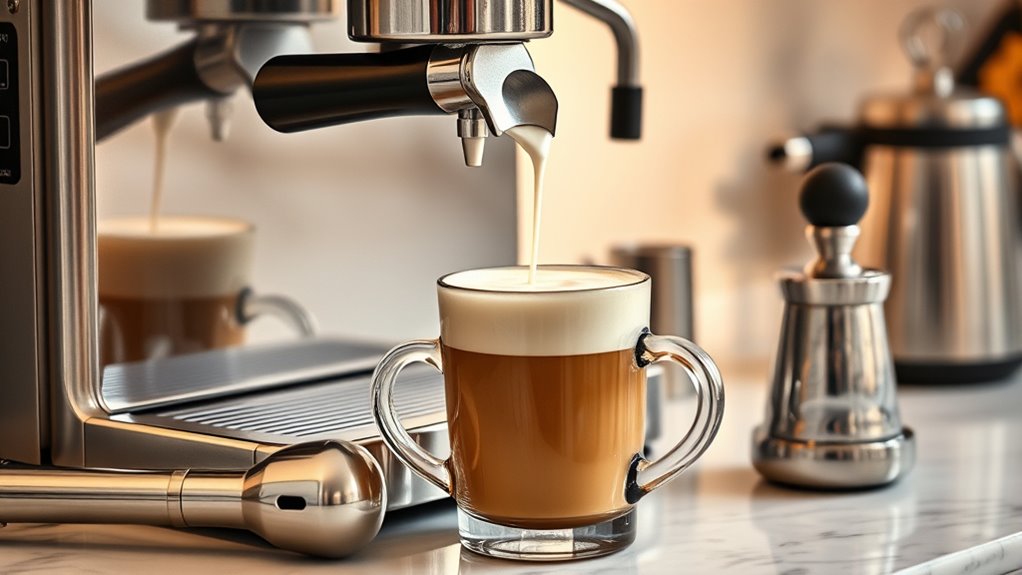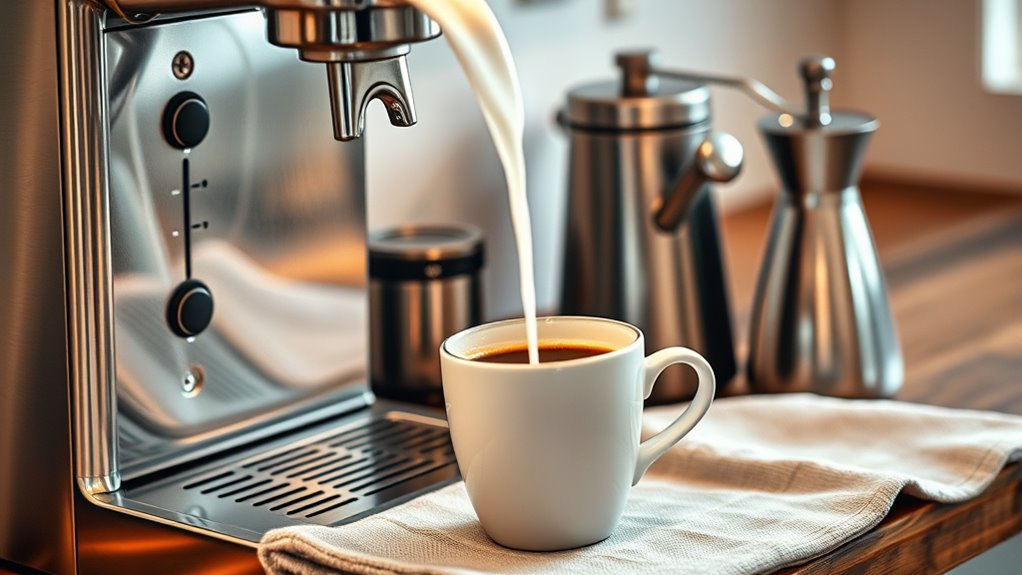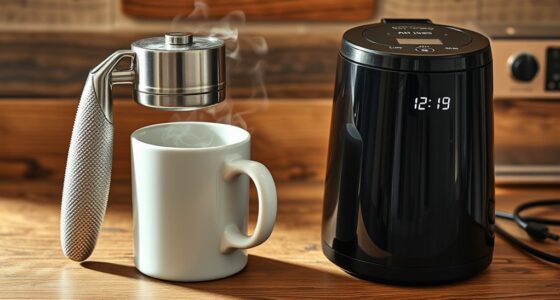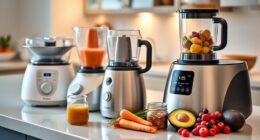To make lattes at home, you’ll want a good-quality espresso machine with a steam wand or a reliable espresso maker paired with a separate milk frother. A machine with a built-in steam wand simplifies milk frothing and guarantees consistent microfoam, while a standalone frother offers more control. Investing in the right equipment makes it easier to produce cafe-quality drinks. Keep exploring to discover tips on choosing the best tools for your perfect latte.
Key Takeaways
- Invest in a quality espresso machine with a built-in steam wand for consistent brewing and frothing.
- Alternatively, use a separate milk frother paired with a good espresso maker for versatile options.
- Consider handheld frothers for quick, small-batch milk steaming, ideal for beginners or limited space.
- Choose machines with adjustable steam pressure to control milk texture and achieve silky microfoam.
- Ensure equipment is easy to clean and maintain for optimal performance and longevity.

Making lattes at home is easier than you might think, and it allows you to enjoy your favorite coffee drinks anytime you want. The key is understanding the right equipment and techniques to create that perfect espresso and velvety steamed milk. One of the most important aspects of crafting a great latte is mastering milk frothing techniques. When you’re frothing milk, you want to introduce just enough air to create a smooth, creamy microfoam without large bubbles. Using a steam wand, you should position the tip just below the surface of the milk and keep the pitcher at an angle to promote even heating and frothing. As the milk heats, you’ll see it expand, and when it reaches the right temperature—around 150°F—you want to turn off the steam to prevent overheating. The goal is to produce a glossy, silky foam that integrates seamlessly into your espresso shot, giving your latte that rich, creamy texture.
Additionally, some fancy coffee machines come with specialized steam wands that make frothing easier and more consistent, which can be a worthwhile investment for home baristas. Equally important is your coffee bean selection. Not all beans are created equal, and choosing high-quality, freshly roasted beans can make a noticeable difference in your espresso’s flavor. Look for beans with a roast date on the packaging, and opt for a medium to dark roast for a fuller, more robust flavor that holds up well in milk. Experimenting with different origins can also help you discover your preferred flavor profile, whether it’s the fruity notes of Ethiopian beans or the chocolatey undertones of Brazilian beans. Grinding your beans just before brewing is essential to preserve freshness, as pre-ground coffee quickly loses its aroma and flavor. Using the right grind size—usually a fine consistency for espresso—ensures ideal extraction, resulting in a rich, flavorful shot that forms the foundation of your latte. Additionally, understanding coffee brewing methods can help you optimize your extraction process for the best taste.
When you combine good coffee bean selection with effective milk frothing techniques, you’re well on your way to making café-quality lattes at home. Invest in a quality espresso machine with a steam wand if possible, but even a good espresso maker paired with a separate milk frother can do the trick. Practice makes perfect, so don’t get discouraged if your initial attempts aren’t flawless. As you gain confidence, you’ll start to develop your own style—whether that’s a perfectly textured microfoam or experimenting with different beans and roasts. Remember, the joy of making lattes at home lies in customizing each cup to your taste, and with a little effort, you can enjoy barista-quality drinks whenever you want.
Frequently Asked Questions
Can I Make a Latte Without an Espresso Machine?
You can definitely make a latte without a home espresso machine. Using strong brewed coffee or a concentrated coffee shot works well, and you can froth your milk using various milk frothing techniques like a handheld frother or a jar with a lid. These methods help you achieve that creamy texture, making your homemade latte just as delightful without needing specialized equipment. Give it a try and enjoy your coffee!
What’S the Best Milk Alternative for Lattes?
When choosing a milk alternative for your latte, consider dairy versus plant-based options. Dairy milk offers protein and calcium, while plant-based milks like almond, oat, or soy often have fewer calories and are suitable for lactose intolerance. Nutritional differences matter, so pick one that fits your dietary needs. Oat milk, for example, provides creaminess and nutrients, making it a popular choice for a rich, satisfying latte.
How Long Does Steamed Milk Stay Frothy?
Steamed milk stays frothy for about 1 to 2 minutes, but its milk foam longevity varies with technique and milk type. For better steamed milk stability, use fresh, cold milk and steam it properly, creating a dense, glossy foam. If you don’t serve immediately, the foam will start to collapse, so enjoy your latte quickly for the best texture. Proper steaming guarantees longer milk foam longevity and a delightful coffee experience.
Is a Manual or Automatic Espresso Machine Better?
When choosing between a manual and automatic espresso machine, consider ease of use and control. If you prefer more hands-on involvement and want to craft each shot precisely, a manual machine is better. However, if you value convenience and consistency, an automatic machine is ideal. You’ll find that automatic models save time and effort, making your espresso experience simpler, while manual options offer a more engaged, customizable brewing process.
Can I Make Latte Art at Home?
Yes, you can make latte art at home! To do so, focus on creating the right foam art with smooth, glossy milk that has good milk texture. Practice steaming your milk to develop microfoam, which makes pouring easier and results in better designs. With patience and a steady hand, you can master simple shapes and even intricate patterns, turning your homemade lattes into beautiful works of foam art.
Conclusion
Now that you know your equipment options, crafting a perfect latte at home becomes an inviting journey. Imagine your kitchen transforming into a cozy café, where each espresso shot and steamed milk blend like a painter’s brushstrokes on a canvas. With the right tools and a bit of practice, you’ll create a masterpiece in every cup. So, grab your equipment, embrace the process, and turn your home into a haven of café-quality lattes—art in every sip.









